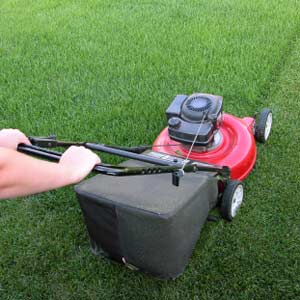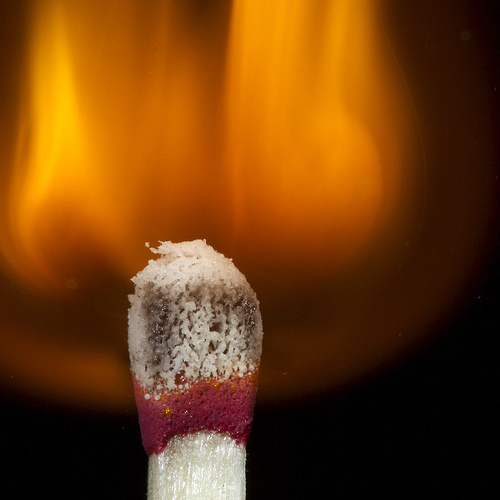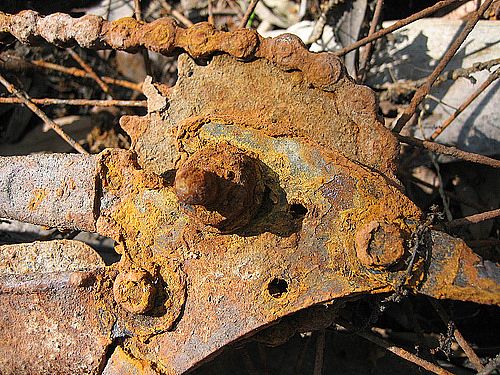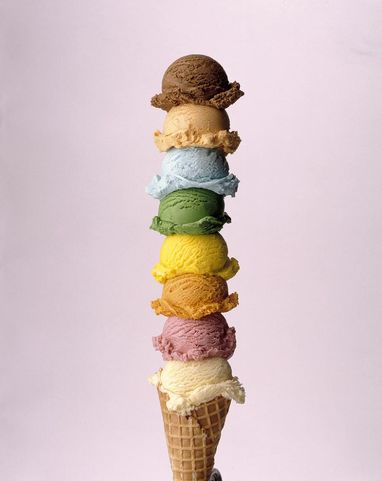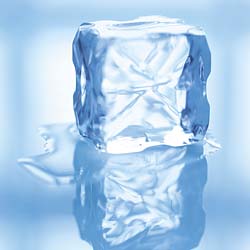Chapter 7- Chemical Reactions
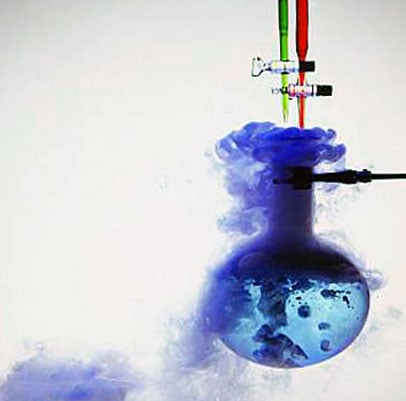
Students will be assessed on their understanding of chemical reactions, chemical and physical changes, writing chemical formulas and balancing chemical equations.
- 1.
The process in which one or more substances change to make one or more new substances is called?
- A.
Chemical change
- B.
Chemical reaction
- C.
Chemical process
- D.
Chemical explosion
Correct Answer
B. Chemical reactionExplanation
A chemical reaction refers to the process in which one or more substances undergo a chemical change to form one or more new substances. This involves the breaking and formation of chemical bonds, resulting in the rearrangement of atoms to create different molecules. It typically involves the release or absorption of energy, such as heat or light. Chemical reactions are fundamental to understanding and studying the behavior of matter and are essential in various fields, including chemistry, biology, and industry.Rate this question:
-
- 2.
How can you tell when a chemical reaction is taking place? (check all that apply)
- A.
A gas forms
- B.
Substance turns to a liquid
- C.
Energy is given off
- D.
There is a color change
Correct Answer(s)
A. A gas forms
C. Energy is given off
D. There is a color changeExplanation
Reactions often have more than one sign. The more signs you see, the more likely a chemical reaction is taking place.Rate this question:
-
- 3.
Angela has been given an unknown substance. She has been asked to determine if this substance will react chemically with water. Which of the following best illustrates that a chemical change has happened?
- A.
When added to the water, the substance settled to the bottom of the beaker.
- B.
The substance dissolved in the water. When the water evaporated, the unknown substance remained.
- C.
The substance floated on the surface of the water.
- D.
When mixed with water, bubbles and heat were generated.
Correct Answer
D. When mixed with water, bubbles and heat were generated.Explanation
Bubbles are a sign that gas is produced which is a sign of a chemical reaction. Heat (energy) given off is also a sign.Rate this question:
-
- 4.
Why is charcoal burning in a grill an example of a chemical change?
- A.
New atoms are created.
- B.
New substances are produced.
- C.
Chemical bonds are not broken.
- D.
Charcoal changes from a solid to a gas.
Correct Answer
B. New substances are produced.Explanation
When charcoal burns in a grill, it undergoes a chemical change because new substances are produced. During the combustion process, the carbon in charcoal reacts with oxygen from the air to form carbon dioxide, water vapor, and other byproducts. These new substances have different chemical properties compared to the original charcoal, indicating a chemical change has occurred. The formation of new substances is a characteristic of chemical reactions, distinguishing them from physical changes where no new substances are formed.Rate this question:
-
- 5.
What evidence in the photo supports the claim that a chemical reaction is taking place?
- A.
Color change
- B.
Liquid is boiling
- C.
Gas produced
- D.
Precipitate
Correct Answer(s)
A. Color change
C. Gas producedExplanation
In the photo, the evidence supporting the claim that a chemical reaction is taking place is the presence of a color change and the production of gas. A color change indicates a change in the chemical composition of the substances involved, suggesting a chemical reaction. Additionally, the production of gas is another indication of a chemical reaction, as the formation of new substances often results in the release of gas.Rate this question:
-
- 6.
A ______________________ is a shorthand way to use chemical symbols and numbers to represent a substance.
Correct Answer(s)
chemical formulaExplanation
A chemical formula is a shorthand notation used to represent the composition of a chemical compound. It uses chemical symbols to indicate the elements present in the compound and subscripts to indicate the number of atoms of each element. For example, the chemical formula for water is 1 H2O, indicating that it contains two hydrogen atoms and one oxygen atom.Rate this question:
- 7.
The starting materials in a chemical reaction are called the ______________________.
Correct Answer(s)
reactants
reactantExplanation
The starting materials in a chemical reaction are referred to as reactants. Reactants are the substances that undergo a chemical change and are consumed during the reaction. They are typically written on the left side of a chemical equation, indicating the substances that are present before the reaction takes place. In some cases, there may be multiple reactants involved in a reaction, and each reactant contributes to the overall chemical transformation.Rate this question:
- 8.
A _____________________________________ uses symbols and formulas as a shortcut to describe a chemical reaction.
Correct Answer(s)
chemical equation
chemical equationsExplanation
A chemical equation is a representation of a chemical reaction using symbols and formulas. It provides a concise and standardized way to describe the reactants, products, and conditions involved in a reaction. By using this shorthand notation, chemists can easily communicate and understand the details of a reaction without having to write out lengthy descriptions. The use of chemical equations allows for efficient documentation and analysis of chemical reactions in various fields, such as research, industry, and education.Rate this question:
- 9.
The ____________________________ are the substances that are formed after a chemical reaction takes place.
Correct Answer(s)
product
productsExplanation
The term "products" refers to the substances that are formed after a chemical reaction takes place. In a chemical reaction, the reactants undergo a transformation and combine to form new substances, which are called products. These products can be a single substance or a combination of multiple substances, depending on the nature of the reaction. Therefore, "product" and "products" both accurately describe the substances formed after a chemical reaction.Rate this question:
- 10.
The __________________________________________ says that mass cannot be created or destroyed.
Correct Answer(s)
law of conservation of massExplanation
The law of conservation of mass states that mass cannot be created or destroyed. This means that in any chemical reaction or physical change, the total mass of the substances involved remains constant. This principle is a fundamental concept in chemistry and is supported by numerous experimental observations. It implies that atoms are rearranged during reactions, but the total number of atoms remains the same. This law is crucial in understanding the behavior and transformations of matter.Rate this question:
- 11.
Mowing the lawn
- A.
Chemical change
- B.
Physical change
Correct Answer
B. Physical changeExplanation
Mowing the lawn is a physical change because it does not alter the chemical composition of the grass or any other substances involved. It is simply a mechanical process of cutting the grass into smaller pieces. The grass remains the same in terms of its chemical properties before and after mowing, only its physical appearance changes.Rate this question:
-
- 12.
burning match
- A.
Chemical change
- B.
Physical change
Correct Answer
A. Chemical changeExplanation
When a match is burned, it undergoes a chemical change. This is because the matchstick contains chemicals such as sulfur and phosphorus, which react with oxygen in the air when ignited. As a result of this chemical reaction, new substances are formed, including carbon dioxide, water vapor, and ash. This change is irreversible, as the original matchstick cannot be restored. Therefore, the burning of a match is an example of a chemical change rather than a physical change.Rate this question:
-
- 13.
rusting bicycle chain
- A.
Chemical change
- B.
Physical change
Correct Answer
A. Chemical changeExplanation
Rusting of a bicycle chain is a chemical change because it involves a chemical reaction between iron in the chain and oxygen in the air, resulting in the formation of iron oxide. This reaction changes the composition and properties of the chain, making it a permanent and irreversible change. Physical changes, on the other hand, do not alter the chemical composition of a substance.Rate this question:
-
- 14.
making ice cream
- A.
Chemical change
- B.
Physical change
Correct Answer
B. Physical changeExplanation
Making ice cream involves transforming ingredients from a liquid state to a semi-solid state through chilling and churning. This alters the physical form and texture but doesn't change the chemical composition of the ingredients. The milk, cream, sugar, etc., remain the same substances, just in a different physical state.Rate this question:
-
- 15.
Ice cube melting
- A.
Chemical change
- B.
Physical change
Correct Answer
B. Physical changeExplanation
The melting of an ice cube is a physical change because it does not involve any chemical reactions or the formation of new substances. Instead, it is a change in state from a solid to a liquid due to the absorption of heat energy. The molecules in the ice cube remain the same, only their arrangement and movement change. Therefore, the melting of an ice cube is considered a physical change.Rate this question:
-
- 16.
Write the chemical formula for dinitrogen monoxide.
Correct Answer
N2OExplanation
di- means there are two atoms of nitrogen and mono- means there is one atom of oxygen.Rate this question:
- 17.
Is the chemical equation balanced? Na + Cl2 -------------------> NaCl
- A.
Yes
- B.
No
Correct Answer
B. NoExplanation
The chemical equation is not balanced because the number of atoms on both sides of the equation is not equal. On the left side, we have one sodium atom (Na) and two chlorine atoms (Cl2), while on the right side, we only have one sodium chloride molecule (NaCl). To balance the equation, we need to ensure that the number of atoms of each element is the same on both sides. In this case, we can balance the equation by adding a coefficient of 2 in front of NaCl, resulting in 2Na + Cl2 -> 2NaCl.Rate this question:
-
- 18.
Is the chemical equation balanced? 3Mg + N2 -------------> Mg3N2
- A.
Yes
- B.
No
Correct Answer
A. YesExplanation
The chemical equation is balanced because the number of atoms on both sides of the equation is equal. On the reactant side, there are 3 magnesium atoms and 2 nitrogen atoms. On the product side, there are 3 magnesium atoms and 2 nitrogen atoms as well. Therefore, the equation is balanced.Rate this question:
-
- 19.
Write the chemical formula for dinitrogen tetroxide.
Correct Answer
N2O4Explanation
Dinitrogen tetroxide is a chemical compound composed of two nitrogen atoms and four oxygen atoms. The chemical formula N2O4 represents this compound, indicating that there are two nitrogen atoms and four oxygen atoms in each molecule of dinitrogen tetroxide.Rate this question:
- 20.
Write the chemical formula for carbon monoxide.
Correct Answer
COExplanation
The chemical formula for carbon monoxide is CO. This formula represents a molecule composed of one carbon atom (C) and one oxygen atom (O). The carbon and oxygen atoms are bonded together by a covalent bond, forming a stable compound. Carbon monoxide is a colorless, odorless gas that is produced by the incomplete combustion of carbon-containing substances. It is highly toxic and can be harmful to humans and animals when inhaled in high concentrations.Rate this question:
- 21.
Write the chemical formula for trisulfur hexachloride.
Correct Answer
S3Cl6Explanation
The chemical formula for trisulfur hexachloride is S3Cl6 because it indicates that there are three sulfur atoms bonded to six chlorine atoms. The prefix "tri" indicates three sulfur atoms, while the prefix "hexa" indicates six chlorine atoms. The subscript numbers represent the number of atoms present in the compound.Rate this question:
Quiz Review Timeline +
Our quizzes are rigorously reviewed, monitored and continuously updated by our expert board to maintain accuracy, relevance, and timeliness.
-
Current Version
-
Nov 24, 2024Quiz Edited by
ProProfs Editorial Team -
Dec 03, 2009Quiz Created by
Odtanner
 Back to top
Back to top



